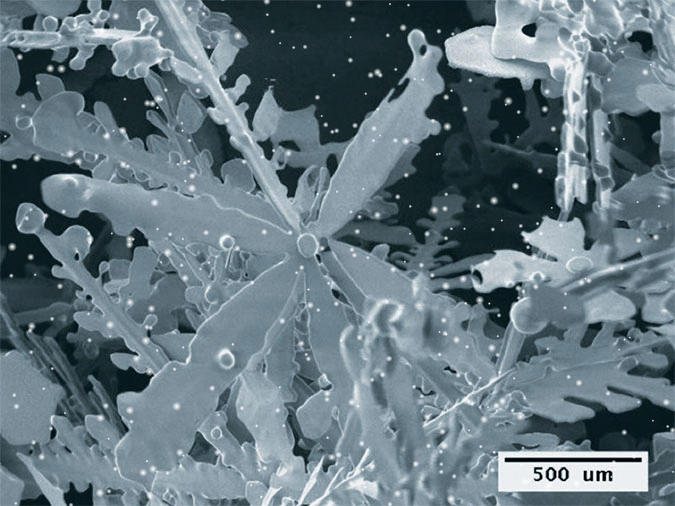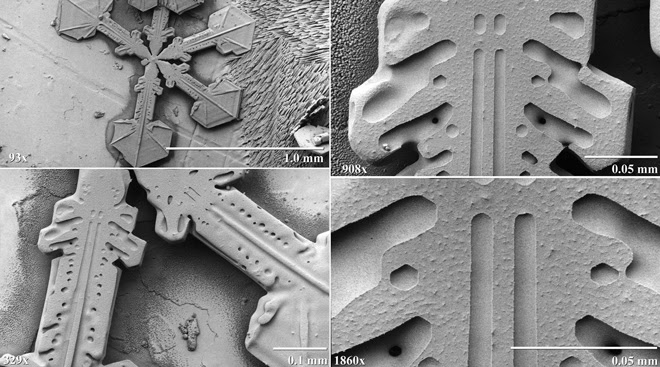Snow!
Snow!
Via Kay Shaw
Originally shared by Rajini Rao
The Science of Snow!
❆ Stellar dendrites are falling. Rimed crystals are piling on so heavily, they you may see graupel. If you're lucky you may spot a split star or a rare capped column. No, I'm not talking gibberish! You can check the “Meteorological Classification of Natural Snow Crystals,” (1966) by Magano and Lee. Did you know that there are 80 official patterns of snowflakes? Their characteristic 6-sided shape comes from the hexagonal lattice of water molecules: each vertex has an oxygen atom with the edges formed by hydrogen bonds on either side (see http://goo.gl/8ZUI0G).
❆ Is it true that no two snowflakes are alike? The short answer is yes! At the atomic level, suppose one snow crystal has 10^18 water molecules, of which 10^15 will contain deuterium isotope (hydrogen with mass of 2 instead of 1) or an isotope of oxygen (mass of 18 instead of the more common 16). Imagine the different ways these could be arrange in the crystal. Then consider the hundreds of different morphological features of snowflakes and the ways they may be arranged. If 100 books could be arranged on a shelf in 10^158 ways (1 followed by 158 zeroes, which is more than all the estimated atoms in the universe), the probability that two identical snowflakes exist is infinitesimally small.
❆ How to view a snowflake at >1,000 times magnification? What you see will surprise you. They don't look quite that regular or perfect. Their art form is more steam punk than a Hallmark holiday card. You may even see the face of Optimus Prime or an alien starship.
1) Capture freshly fallen snow from around the country. It's more naturally diverse than the man-made stuff that is smooth and gob-like.
2) Brush the flakes on to a pre-chilled copper plate coated with a gel of methyl cellulose.
3) Chill right away in liquid nitrogen, down to -196 C.
4) Mount on a scanning electron microscope with a viewing stage chilled to -176 C.
5) Justify your work: "'Information gained from studying the structure of snow is vital to several areas of science as well as to activities that affect our daily lives..." from USDA.gov :)
Happy Holidays!
REF: For all you wanted to know about snow and more http://goo.gl/nDnTM
Cover Photograph by Ph.D. candidate Si Chen. Dartmouth Engineer Magazine http://goo.gl/FsqqR1
Others: The Electron Microscopy Unit of the Beltsville Agricultural Research Center in Beltsville http://goo.gl/xteHY
#ScienceEveryday #HolidayScience







Via Kay Shaw
Originally shared by Rajini Rao
The Science of Snow!
❆ Stellar dendrites are falling. Rimed crystals are piling on so heavily, they you may see graupel. If you're lucky you may spot a split star or a rare capped column. No, I'm not talking gibberish! You can check the “Meteorological Classification of Natural Snow Crystals,” (1966) by Magano and Lee. Did you know that there are 80 official patterns of snowflakes? Their characteristic 6-sided shape comes from the hexagonal lattice of water molecules: each vertex has an oxygen atom with the edges formed by hydrogen bonds on either side (see http://goo.gl/8ZUI0G).
❆ Is it true that no two snowflakes are alike? The short answer is yes! At the atomic level, suppose one snow crystal has 10^18 water molecules, of which 10^15 will contain deuterium isotope (hydrogen with mass of 2 instead of 1) or an isotope of oxygen (mass of 18 instead of the more common 16). Imagine the different ways these could be arrange in the crystal. Then consider the hundreds of different morphological features of snowflakes and the ways they may be arranged. If 100 books could be arranged on a shelf in 10^158 ways (1 followed by 158 zeroes, which is more than all the estimated atoms in the universe), the probability that two identical snowflakes exist is infinitesimally small.
❆ How to view a snowflake at >1,000 times magnification? What you see will surprise you. They don't look quite that regular or perfect. Their art form is more steam punk than a Hallmark holiday card. You may even see the face of Optimus Prime or an alien starship.
1) Capture freshly fallen snow from around the country. It's more naturally diverse than the man-made stuff that is smooth and gob-like.
2) Brush the flakes on to a pre-chilled copper plate coated with a gel of methyl cellulose.
3) Chill right away in liquid nitrogen, down to -196 C.
4) Mount on a scanning electron microscope with a viewing stage chilled to -176 C.
5) Justify your work: "'Information gained from studying the structure of snow is vital to several areas of science as well as to activities that affect our daily lives..." from USDA.gov :)
Happy Holidays!
REF: For all you wanted to know about snow and more http://goo.gl/nDnTM
Cover Photograph by Ph.D. candidate Si Chen. Dartmouth Engineer Magazine http://goo.gl/FsqqR1
Others: The Electron Microscopy Unit of the Beltsville Agricultural Research Center in Beltsville http://goo.gl/xteHY
#ScienceEveryday #HolidayScience







Comments